How To Use An Elliptical: 7 Essential Steps
Author:
Unlock your full potential by engaging with our experts and community! Have questions about your fitness journey or looking for expert advice on weightlifting techniques? Don’t hesitate — leave a comment below and Ihor Shymechko will provide a personalized answer and insights to help you reach your goals.
Torokhtiy is reader-supported. Some links are affiliate links, and we may earn a commission at no extra cost to you. See our disclosure page for details.
So, you’ve come across an elliptical machine at the gym or you’re thinking about getting one for your home. But are you sure you know how to use an elliptical?
In this guide, we’re talking about everything you should know about elliptical training: what it’s good for, why it’s popular, the proper way to use elliptical machines, tips for better workouts, and more.
How To Use An Elliptical? In short: Always start with a warmup. Adjust the machine to your preference, focusing mainly on the resistance level. Maintain proper elliptical form with a straight back, engaged core, and controlled motion. Monitor your heart rate and stay well hydrated.
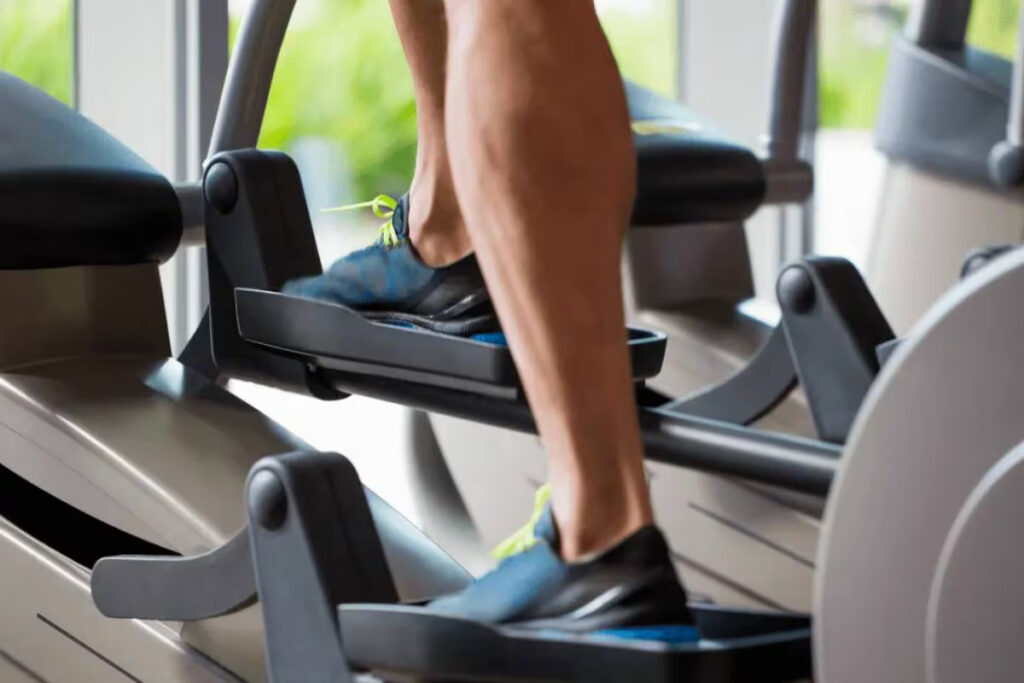
What Is an Elliptical Machine?
An elliptical machine, also known as a cross-trainer, is a popular cardio exercise machine designed to simulate activities like walking, jogging, or running, but with a lower impact on the joints compared to a treadmill.
So, how does an elliptical machine work? For starters, an elliptical does not have speed settings, it’s completely user powered by the two pedals that move in an oval-shaped (elliptical) pattern and handlebars that rock back and forth. As you push the pedals and move the handles, the machine activates a flywheel and magnetic resistance system to create resistance and provide a smooth gliding motion. The resistance can be adjusted using the machine’s console, allowing you to customize the intensity of your workout.
Elliptical machine offers a low-impact workout as your feet aren’t pushing against solid ground, but rather pedals that are pushed back by air resistance. This significantly reduces the stress on your joints, particularly the knees and ankles, making ellipticals especially good for people with injuries, chronic pain, or brittle bones. Compared to other cardio exercises like walking, ellipticals boast an above-average calorie consumption in a 1-hour training session, especially considering the lower workout intensity.
How to Use an Elliptical?
Knowing how to turn on elliptical machines is just the first step to working out. Whether you are a novice or an expert with them, there are some steps you always need to take to ensure you have a safe and effective time using ellipticals.
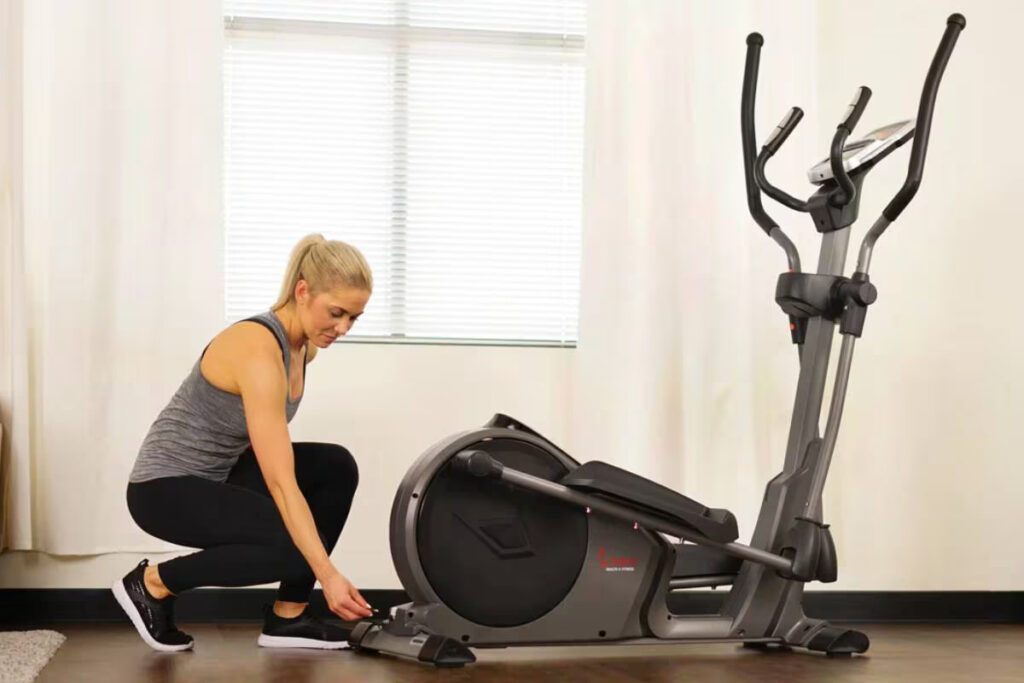
1. Warm Up First
This is a generally good first tip for any exercise session. Warmups are an important part of cardio sessions and research shows they’re highly effective for preventing injuries in lower extremities. Before you jump onto your elliptical, it’s crucial to warm up your muscles and gradually increase your heart rate, thus signaling your body and mind to enter “workout” mode. Five to ten minutes of light stretching, dynamic movements, and balance and agility drills will go a long way for you.
2. Adjust Your Settings
Once you step on, take a moment to ensure the settings on the elliptical machine are adjusted to your preferred workout. This mostly includes setting the resistance level, which primarily determines the difficulty of the exercise. Additionally, some ellipticals have adjustable pedals and handlebars, so make sure everything is within your reach before you start working.
3. Start Slow And Work Your Way Up
When you’re ready to begin your workout, start with a slow and comfortable pace. This allows you to feel out your body for any outstanding issues, such as pain or discomfort, and allows you to test out the machine for signs of wear and tear, or unusual noises. After about a minute doing this, feel free to up the exercise intensity. Gradually increase your speed and intensity to challenge yourself and receive a more vigorous workout in return.
4. Maintain Proper Posture
Using proper elliptical form is crucial for maximizing the effectiveness of your workout and minimizing the risk of injury. Keep your back straight, shoulders relaxed, and core engaged throughout the exercise. Keep your head up and look forward, avoid slouching or leaning into the machine, as this reduces exercise efficiency and strains your back. Focus on using a smooth and controlled motion, pushing the pedals forward and downward while simultaneously pulling the handles back and forth.
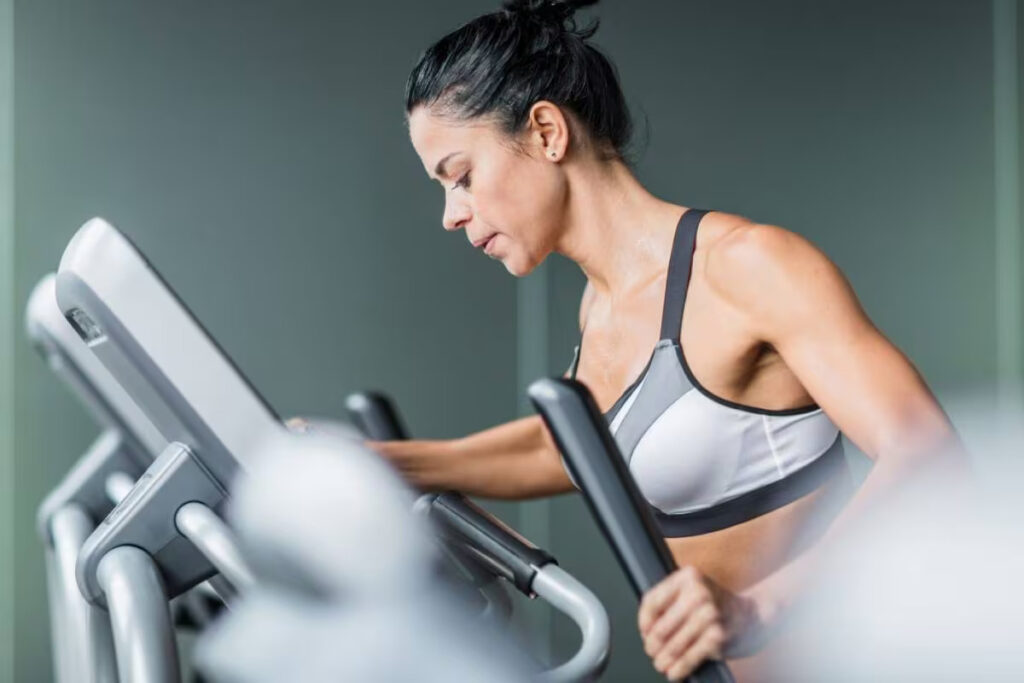
5. Monitor Your Heart Rate
Monitoring your heart rate is an excellent way to measure the intensity of your workout and ensure you’re within your target zone. Many elliptical machines come with built-in heart rate sensors that you can grip to measure your heart rate. Alternatively, you can use a wearable device that tracks your heart rate and syncs with the elliptical machine, such as a heart rate strap or smartwatch.
Maintain your heart rate within the target range for your fitness goals. According to the CDC, moderate activities should aim for 64-76% of maximum beats per minute (BPM), while intense activities target 77-93%. To calculate your approximate max BPM, simply subtract your age from 220. Additionally, it’s always a good idea to consult a healthcare professional or physical therapist for personalized target heart rate recommendations based on your age, fitness level, and overall health.
6. Don’t Forget To Hydrate
During your elliptical workout, it’s important to stay hydrated. Hydration keeps you topped up both physically and mentally. According to research, the healthiest way to hydrate is a steady intake of fluid throughout the workout, as opposed to periodically taking big sips, such as during breaks. Keep a water bottle within reach and take regular sips of water throughout your exercise session. Sweating and increased exertion can lead to dehydration, so make sure to replenish your fluids to maintain optimal performance and prevent any potential health issues.
7. Maintain Your Elliptical
Proper maintenance of your elliptical machine is essential to ensure its longevity and optimal performance in the upcoming years. Regularly clean the machine after every use to remove sweat and dust. Over time moving parts will require lubricating, loose bolts and screws will have to be tightened, and the console battery may need replacement. For specific maintenance recommendations, care products, and schedules, you should refer to the user manual or warranty, as this is where you typically find this info.
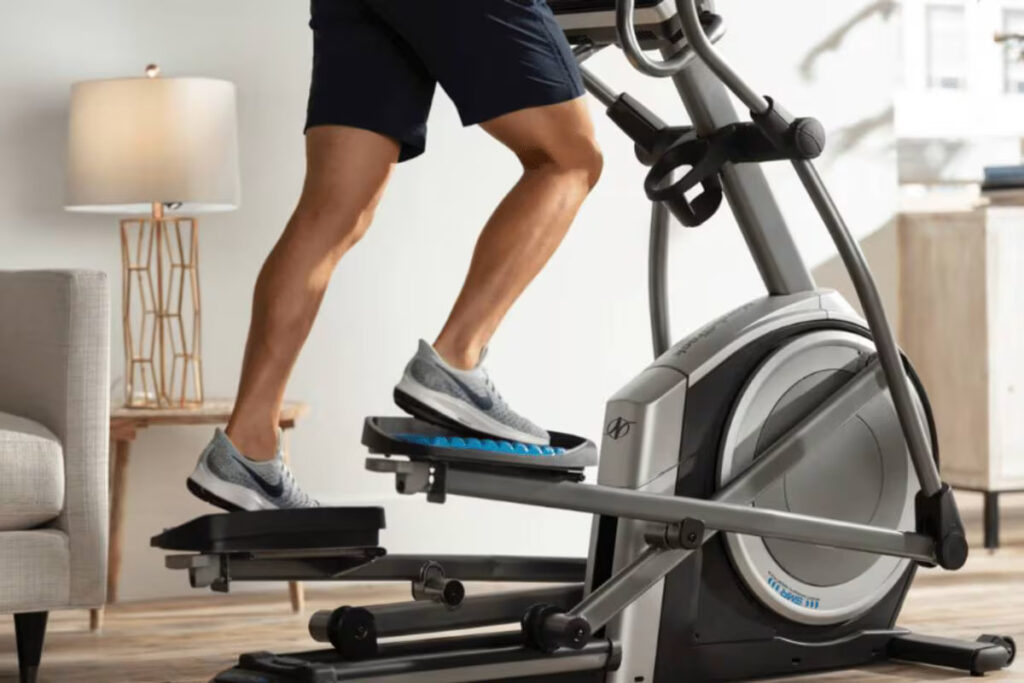
4 Tips for Effective Elliptical Training
Now that you’ve got the hang of your elliptical, you can try to widen your exercise approach. Here are some additional tips on how to use elliptical machines, to ensure you have a safe, effective, and fun workout on your elliptical.
1. Keep Your Entire Foot Down
When using an elliptical machine, it’s generally recommended to place your entire foot on the foot pedals for optimal stability and support. This means that your entire foot, from your toes to the heel, should make contact with the pedal. This helps distribute your weight evenly and allows for a more comfortable and effective workout. Additionally, maintaining proper foot placement can help prevent strain or discomfort in your feet and lower limbs.
If you have issues such as high-arch feet, make sure to get proper training shoes that help you simulate stepping with your full foot. Alter your step only in situations where you’re going for specific muscle targeting, such as stepping with the balls of your feet to activate the calves.
2. Don’t Push With Your Arms
When using an elliptical machine, the primary focus should be on engaging the lower body muscles, particularly the legs and glutes. While the arms do play a secondary role in providing support and balance, you should avoid pushing with and relying heavily on the arm handles for propulsion.
Instead, the arms should swing back and forth in a natural motion to help maintain overall coordination and balance, without feeling too much resistance. This allows for a more efficient and effective workout that primarily targets the lower body muscles while still involving the upper body in a supportive manner. Only use your arm strength for propulsion if you’re specifically targeting your upper body.
3. Try Backward Pedaling
Many ellipticals are built with the option of backward pedaling. This type of exercise approach can be a fun and beneficial way to spice up your workout routine. Pedaling in reverse targets nearly identical muscle groups but with a greater emphasis on the backside of your legs, such as the hamstrings, calves, and glutes. It can also help improve balance and coordination. However, it’s important to note that if you have any pre-existing joint or knee issues, you should consult with a healthcare professional before attempting backward pedaling on the elliptical.
4. Try Lateral Movements
Many elliptical machines allow the freedom of lateral movements by moving your feet and legs in a side-to-side motion. This added movement can additionally target muscles of the inner and outer thighs and puts more emphasis on the glutes overall. You can alternate stepping or skating motions, thus also challenging your balance and mobility. For example, an elliptical can simulate a motion similar to skiing, utilizing the benefits of this popular winter sport from the comfort of your home.
The Elliptical Trainer We Recommend – Sunny Health & Fitness Premium Elliptical Exercise Machine
The Sunny Health & Fitness Premium Elliptical is a compact and durable rear-drive standing elliptical designed for home use. With 16 resistance levels and 24 built-in workout modes, it provides versatile options for your fitness routine. Made from strong alloy steel, it has a maximum user capacity of 330 lbs, backed by a 3-year structural frame warranty plus 180-day coverage on parts and components.
The elliptical is available in two versions, the base model and “Smart”. Both come with a digital display that keeps you informed of essential workout metrics, including calories burned, distance, heart rate, and speed. The Smart version has the added benefit of Bluetooth connectivity, allowing you to sync it with the SunnyFit smart device app. The app offers real-time stat tracking, progress monitoring, leaderboard comparison, and access to over 100 workout videos.
FAQ
Is 30 Minutes On An Elliptical Enough Exercise?
Whether or not 30 minutes on your elliptical is enough exercise entirely depends on your training frequency, intensity level, and fitness and health goals. The World Health Organization (WHO) recommends at least 150-300 minutes of moderate-intensity or 75-150 minutes of vigorous-intensity exercise per week for adults.
How you choose to approach this is entirely up to you, though it’s generally recommended to have 3-4 workout sessions per week (every other day) for consistency. Remember that vigorous exercise typically elevates your heart rate to around 77-93% of your maximum heart rate, while Moderate exercise falls within the 64-76% range. Play around with resistance and speed on your elliptical until you find your ideal heart rate spot.
Is It Better To Walk Or Do The Elliptical?
Whether or not ellipticals are better than walking for you depends on factors such as workout goals and personal health, but these are the facts. We’ve already mentioned how ellipticals have better calorie consumption than low to moderately intense cardio like walking. They also put noticeably less stress on the body, particularly the lower body joints. Furthermore, ellipticals have higher core and glute muscle activation than walking.
How To Use An Elliptical For Beginners?
Start with a warmup to prevent injuries. Adjust the machine settings, including resistance level, pedals, and handlebars, for a comfortable workout. Start at a slow pace and gradually increase intensity. Maintain proper posture, with a straight back, engaged core, forward gaze, and controlled motion. Monitor your heart rate to stay within your target zone. Remember to hydrate by regularly sipping water throughout the workout.
Conclusion
You’ve reached the end of our guide on how to use an elliptical machine. To summarize, ellipticals are effective tools for daily cardio, weight loss, and targeting both functional and aesthetic lower-body muscle groups. They provide a near full-body workout while having a lower impact on your extremities even compared to regular walking, making them quite user-friendly and forgiving.
Our recommended elliptical model to get is the Sunny Health & Fitness Premium Elliptical Exercise Machine. With this knowledge under your belt, you can rest assured you know the proper way to use ellipticals and are ready to get started. Now let us know your thoughts:
Are you planning on getting an elliptical for your home, apartment, or garage gym? If so, we’d love to know what your training goals will be. Remember, we post all kinds of valuable fitness content on our website and over on social media, so make sure you give us a follow and keep in touch.
Also read:
- Walking Vs Elliptical
- Best Budget Elliptical
- Best Compact Elliptical
- Elliptical vs Stair Climber
- What Muscles Does the Elliptical Work
- Does Elliptical Build Muscle
References:
- Exercise for weight loss: Calories burned in 1 hour // Mayoclinic: https://www.mayoclinic.org/healthy-lifestyle/weight-loss/in-depth/exercise/art-20050999?pg=2
- The effectiveness of neuromuscular warm-up strategies, that require no additional equipment, for preventing lower limb injuries during sports participation: a systematic review // Bmcmedicine: https://bmcmedicine.biomedcentral.com/articles/10.1186/1741-7015-10-75
- The Effect of Fluid Intake Following Dehydration on Subsequent Athletic and Cognitive Performance: a Systematic Review and Meta-analysis // Ncbi: https://www.ncbi.nlm.nih.gov/pmc/articles/PMC5357466/
- Physical activity // Who: https://www.who.int/news-room/fact-sheets/detail/physical-activity
- Referent body weight values in over ground walking, over ground jogging, treadmill jogging, and elliptical exercise // Pubmed: https://pubmed.ncbi.nlm.nih.gov/24095267/
Why Trust Us?
With over 20 years in Olympic weightlifting, strength training, nutrition coaching, and general fitness our team does its best to provide the audience with ultimate support and meet the needs and requirements of advanced athletes and professional lifters, as well as people who strive to open new opportunities and develop their physical capabilities with us.
By trusting the recommendations of our certified experts in coaching, nutrition, and sports training programming, as well as scientific consultants, and physiotherapists, we provide you with thorough, well-considered, and scientifically proven content. All the information given in the articles concerning workout programming, separate exercises, and athletic performance, in general, is based on verified data.
The product testing process is described in more detail here.
Author: Ihor Shymechko
Pro Olympic Weightlifter, Coach
Best Results: Snatch – 208 kg,
C&J – 240 kg
Ihor has been a professional weightlifter since 1996, boasting over two decades of competition experience. His notable achievements include clinching the European Championship in 2009 and securing a silver medal in the 105kg division at the Senior World Championships in 2011. Ihor represented his country in the 2008, 2012, and 2016 Summer Olympics. After retiring from competitive weightlifting, he transitioned to coaching, leveraging his vast experience to guide athletes who now compete on both national and international stages.



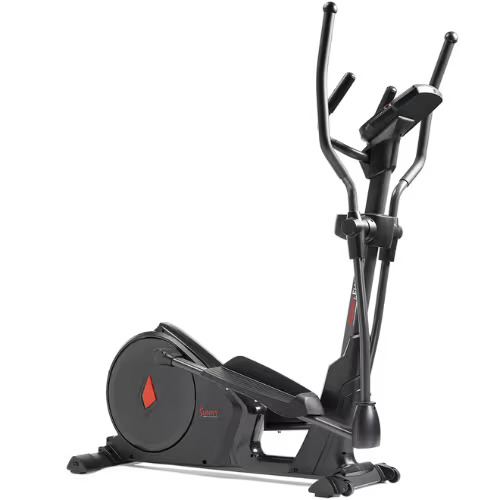
Still have questions after reading our article? Unlock your full potential by engaging with our experts and community! Don’t hesitate — leave a comment below and Ihor Shymechko will provide a personalized answer and insights to help you reach your goals.